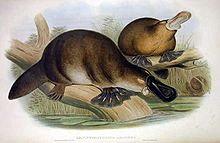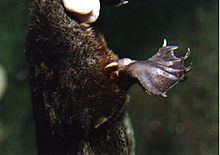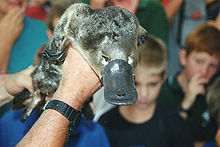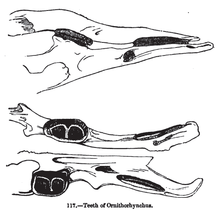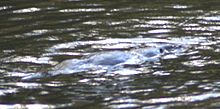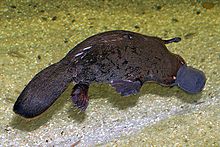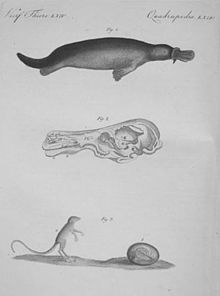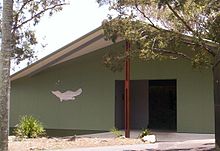
Platypus
About this schools Wikipedia selection
SOS Children volunteers helped choose articles and made other curriculum material Do you want to know about sponsoring? See www.sponsorachild.org.uk
| Platypus Temporal range: 66–0Ma Late Cretaceous to Recent |
|
|---|---|
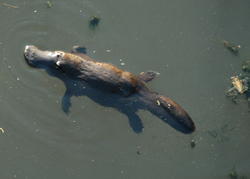 |
|
| Conservation status | |
 Least Concern ( IUCN 3.1) |
|
| Scientific classification | |
| Kingdom: | Animalia |
| Phylum: | Chordata |
| Class: | Mammalia |
| Order: | Monotremata |
| Family: | Ornithorhynchidae |
| Genus: | Ornithorhynchus Blumenbach, 1800 |
| Species: | O. anatinus |
| Binomial name | |
| Ornithorhynchus anatinus ( Shaw, 1799) |
|
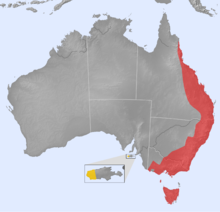 |
|
| Platypus range (red — native, yellow — introduced) |
|
The platypus (Ornithorhynchus anatinus) is a semiaquatic mammal endemic to eastern Australia, including Tasmania. Together with the four species of echidna, it is one of the five extant species of monotremes, the only mammals that lay eggs instead of giving birth. It is the sole living representative of its family ( Ornithorhynchidae) and genus (Ornithorhynchus), though a number of related species have been found in the fossil record.
The unusual appearance of this egg-laying, venomous, duck-billed, beaver-tailed, otter-footed mammal baffled European naturalists when they first encountered it, with some considering it an elaborate fraud. It is one of the few venomous mammals, the male platypus having a spur on the hind foot that delivers a venom capable of causing severe pain to humans. The unique features of the platypus make it an important subject in the study of evolutionary biology and a recognisable and iconic symbol of Australia; it has appeared as a mascot at national events and is featured on the reverse of its 20-cent coin. The platypus is the animal emblem of the state of New South Wales.
Until the early 20th century, it was hunted for its fur, but it is now protected throughout its range. Although captive breeding programmes have had only limited success and the platypus is vulnerable to the effects of pollution, it is not under any immediate threat.
Taxonomy and etymology
When the platypus was first encountered by Europeans in 1798, a pelt and sketch were sent back to Great Britain by Captain John Hunter, the second Governor of New South Wales. British scientists' initial hunch was that the attributes were a hoax. George Shaw, who produced the first description of the animal in the Naturalist's Miscellany in 1799, stated it was impossible not to entertain doubts as to its genuine nature, and Robert Knox believed it might have been produced by some Asian taxidermist. It was thought that somebody had sewn a duck's beak onto the body of a beaver-like animal. Shaw even took a pair of scissors to the dried skin to check for stitches.
The common name "platypus" is the latinisation of the Greek word πλατύπους (platupous), "flat-footed", from πλατύς (platus), "broad, wide, flat" and πούς (pous), "foot". Shaw assigned it as a Linnaean genus name when he initially described it, but the term was quickly discovered to belong already to the wood-boring ambrosia beetle (genus Platypus). It was independently described as Ornithorhynchus paradoxus by Johann Blumenbach in 1800 (from a specimen given to him by Sir Joseph Banks) and following the rules of priority of nomenclature, it was later officially recognised as Ornithorhynchus anatinus. The scientific name Ornithorhynchus anatinus is derived from ορνιθόρυγχος (ornithorhynkhos), which literally means "bird snout" in Greek; and anatinus, which means "duck-like" in Latin.
There is no universally agreed plural of "platypus" in the English language. Scientists generally use "platypuses" or simply "platypus". Colloquially, the term "platypi" is also used for the plural, although this is technically incorrect and a form of pseudo-Latin; the correct Greek plural would be "platypodes". Early British settlers called it by many names, such as watermole, duckbill, and duckmole. The name "platypus" is often prefixed with the adjective "duck-billed" to form duck-billed platypus, despite there being only one species of platypus.
Description
The body and the broad, flat tail of the platypus are covered with dense, brown fur that traps a layer of insulating air to keep the animal warm. The fur is waterproof, and the texture is akin to that of a mole. The platypus uses its tail for storage of fat reserves (an adaptation also found in animals such as the Tasmanian devil and fat-tailed sheep). It has webbed feet and a large, rubbery snout; these features appear closer to those of a duck than to those of any known mammal. The webbing is more significant on the front feet and is folded back when walking on land. Unlike a bird's beak (in which the upper and lower parts separate to reveal the mouth), the snout of the platypus is a sensory organ with the mouth on the underside. The nostrils are located on the dorsal surface of the snout, while the eyes and ears are located in a groove set just back from it; this groove is closed when swimming. Platypuses have been heard to emit a low growl when disturbed and a range of other vocalisations have been reported in captive specimens.
Weight varies considerably from 0.7 to 2.4 kg (1.5 to 5.3 lb), with males being larger than females; males average 50 cm (20 in) in total length, while females average 43 cm (17 in), with substantial variation in average size from one region to another, and this pattern does not seem to follow any particular climatic rule and may be due to other environmental factors, such as predation and human encroachment.
The platypus has an average body temperature of about 32°C (90°F) rather than the 37°C (99°F) typical of placental mammals. Research suggests this has been a gradual adaptation to harsh environmental conditions on the part of the small number of surviving monotreme species rather than a historical characteristic of monotremes.
Modern platypus young have three-cusped molars, which they lose before or just after leaving the breeding burrow; adults have heavily keratinised pads in their place. The platypus jaw is constructed differently from that of other mammals, and the jaw-opening muscle is different. As in all true mammals, the tiny bones that conduct sound in the middle ear are fully incorporated into the skull, rather than lying in the jaw as in cynodonts and other premammalian synapsids. However, the external opening of the ear still lies at the base of the jaw. The platypus has extra bones in the shoulder girdle, including an interclavicle, which is not found in other mammals. It has a reptilian gait, with the legs on the sides of the body, rather than underneath. When on land, it engages in knuckle-walking to protect the webbing between its toes.
Venom
While both male and female platypuses are born with ankle spurs, only the male's spurs produce a cocktail of venom, composed largely of defensin-like proteins (DLPs), three of which are unique to the platypus. The DLPs are produced by the immune system of the platypus. Although powerful enough to kill smaller animals such as dogs, the venom is not lethal to humans, but the pain is so excruciating, the victim may be incapacitated. Oedema rapidly develops around the wound and gradually spreads throughout the affected limb. Information obtained from case histories and anecdotal evidence indicates the pain develops into a long-lasting hyperalgesia (a heightened sensitivity to pain) that persists for days or even months. Venom is produced in the crural glands of the male, which are kidney-shaped alveolar glands connected by a thin-walled duct to a calcaneus spur on each hind limb. The female platypus, in common with echidnas, has rudimentary spur buds which do not develop (dropping off before the end of their first year) and lack functional crural glands.
The venom appears to have a different function from those produced by nonmammalian species; its effects are not life-threatening to humans, but nevertheless powerful enough to seriously impair the victim. Since only males produce venom and production rises during the breeding season, it may be used as an offensive weapon to assert dominance during this period.
Electrolocation
Monotremes (for the other species, see Echidna) are the only mammals (apart from at least one species of dolphin) known to have a sense of electroreception: they locate their prey in part by detecting electric fields generated by muscular contractions. The platypus' electroreception is the most sensitive of any monotreme.
The electroreceptors are located in rostrocaudal rows in the skin of the bill, while mechanoreceptors (which detect touch) are uniformly distributed across the bill. The electrosensory area of the cerebral cortex is contained within the tactile somatosensory area, and some cortical cells receive input from both electroreceptors and mechanoreceptors, suggesting a close association between the tactile and electric senses. Both electroreceptors and mechanoreceptors in the bill dominate the somatotopic map of the platypus brain, in the same way human hands dominate the Penfield homunculus map.
The platypus can determine the direction of an electric source, perhaps by comparing differences in signal strength across the sheet of electroreceptors. This would explain the characteristic side-to-side motion of the animal's head while hunting. The cortical convergence of electrosensory and tactile inputs suggests a mechanism for determining the distance of prey items which, when they move, emit both electrical signals and mechanical pressure pulses; the difference between the times of arrival of the two signals would allow computation of distance.
The platypus feeds by neither sight nor smell, closing its eyes, ears, and nose each time it dives. Rather, when it digs in the bottom of streams with its bill, its electroreceptors detect tiny electrical currents generated by muscular contractions of its prey, so enabling it to distinguish between animate and inanimate objects, which continuously stimulate its mechanoreceptors. Experiments have shown the platypus will even react to an "artificial shrimp" if a small electrical current is passed through it.
Eyes
Recent studies say that the eyes of the platypus could possibly be highly similar to those of Pacific hagfish or Northern Hemisphere lampreys than to those of most tetrapods. Also it contains double cones, which most mammals do not have.
Although the platypus' eyes are small and not used under water, several features indicate that vision played an important role in its ancestors. The corneal surface and the adjacent surface of the lens is flat while the posterior surface of the lens is steeply curved, similar to the eyes of other aquatic mammals such otters and sea-lions. A temporal (ear side) concentration of retinal ganglion cells, important for binocular vision, indicates a role in predation, while the accompanying visual acuity is insufficient for such activities. Furthermore, this limited acuity is matched by a low cortical magnification, a small lateral geniculate nucleus and a large optic tectum, suggesting that the visual midbrain plays a more important role than the visual cortex like in some rodents. These features suggest that the platypus has adapted to an aquatic and nocturnal lifestyle, developing its electrosensory system at the cost of its visual system; an evolutionary process paralleled by the small number of electroreceptors in the short-beaked echidna, who dwells in dry environments, whilst the long-beaked echidna, who lives in moist environments, is intermediate between the other two monotremes.
Ecology and behaviour
The platypus is semiaquatic, inhabiting small streams and rivers over an extensive range from the cold highlands of Tasmania and the Australian Alps to the tropical rainforests of coastal Queensland as far north as the base of the Cape York Peninsula. Inland, its distribution is not well known; it is extinct in South Australia (apart from an introduced population on Kangaroo Island) and is no longer found in the main part of the Murray-Darling Basin, possibly due to the declining water quality brought about by extensive land clearing and irrigation schemes. Along the coastal river systems, its distribution is unpredictable; it appears to be absent from some relatively healthy rivers, and yet maintains a presence in others that are quite degraded (the lower Maribyrnong, for example).
In captivity, platypuses have survived to 17 years of age, and wild specimens have been recaptured when 11 years old. Mortality rates for adults in the wild appear to be low. Natural predators include snakes, water rats, goannas, hawks, owls, and eagles. Low platypus numbers in northern Australia are possibly due to predation by crocodiles. The introduction of red foxes in 1845 for hunting may have had some impact on its numbers on the mainland. The platypus is generally regarded as nocturnal and crepuscular, but individuals are also active during the day, particularly when the sky is overcast. Its habitat bridges rivers and the riparian zone for both a food supply of prey species, and banks where it can dig resting and nesting burrows. It may have a range of up to 7 km (4.3 mi), with a male's home range overlapping those of three or four females.
The platypus is an excellent swimmer and spends much of its time in the water foraging for food. When swimming, it can be distinguished from other Australian mammals by the absence of visible ears. Uniquely among mammals, it propels itself when swimming by an alternate rowing motion of the front feet; although all four feet of the platypus are webbed, the hind feet (which are held against the body) do not assist in propulsion, but are used for steering in combination with the tail. The species is endothermic, maintaining its body temperature at about 32°C (90°F), lower than most mammals, even while foraging for hours in water below 5°C (41°F).
Dives normally last around 30 seconds, but can last longer, although few exceed the estimated aerobic limit of 40 seconds. Recovery at the surface between dives commonly takes from 10 to 20 seconds. The platypus is a carnivore: it feeds on annelid worms, insect larvae, freshwater shrimps, and yabbies (freshwater crayfish) that it digs out of the riverbed with its snout or catches while swimming. It uses cheek-pouches to carry prey to the surface, where it is eaten. The platypus needs to eat about 20% of its own weight each day, which requires it to spend an average of 12 hours daily looking for food. When not in the water, the platypus retires to a short, straight resting burrow of oval cross-section, nearly always in the riverbank not far above water level, and often hidden under a protective tangle of roots.
The average sleep time of a platypus is said to be as long as 14 hours per day, possibly because it eats crustaceans which provide a high level of calories.
Reproduction
When the platypus was first encountered by European naturalists, they were divided over whether the female laid eggs. This was not confirmed until 1884, when W. H. Caldwell was sent to Australia, where, after extensive searching assisted by a team of 150 Aborigines, he managed to discover a few eggs. Mindful of the high cost per word, Caldwell famously but tersely wired London, "Monotremes oviparous, ovum meroblastic." That is, monotremes lay eggs, and the eggs are similar to those of reptiles in that only part of the egg divides as it develops.
The species exhibits a single breeding season; mating occurs between June and October, with some local variation taking place between different populations across its range. Historical observation, mark-and-recapture studies, and preliminary investigations of population genetics indicate the possibility of both resident and transient members of populations, and suggest a polygynous mating system. Females are thought likely to become sexually mature in their second year, with breeding confirmed still to take place in animals over 9 years old.
Outside the mating season, the platypus lives in a simple ground burrow, the entrance of which is about 30 cm (12 in) above the water level. After mating, the female constructs a deeper, more elaborate burrow up to 20 m (66 ft) long and blocked at intervals with plugs (which may act as a safeguard against rising waters or predators, or as a method of regulating humidity and temperature). The male takes no part in caring for its young, and retreats to his year-long burrow. The female softens the ground in the burrow with dead, folded, wet leaves, and she fills the nest at the end of the tunnel with fallen leaves and reeds for bedding material. This material is dragged to the nest by tucking it underneath her curled tail.
The female platypus has a pair of ovaries, but only the left one is functional. The platypus' genes are a possible evolutionary link between XY and ZW sex-determination systems because they have the DMRT1 gene possessed by birds on their X chromosomes. It lays one to three (usually two) small, leathery eggs (similar to those of reptiles), about 11 mm (0.43 in) in diameter and slightly rounder than bird eggs. The eggs develop in utero for about 28 days, with only about 10 days of external incubation (in contrast to a chicken egg, which spends about one day in tract and 21 days externally). After laying her eggs, the female curls around them. The incubation period is divided into three phases. In the first phase, the embryo has no functional organs and relies on the yolk sac for sustenance. The yolk is absorbed by the developing young. During the second phase, the digits develop, and in the last phase, the egg tooth appears.
The newly hatched young are vulnerable, blind, and hairless, and are fed by the mother's milk. Although possessing mammary glands, the platypus lacks teats. Instead, milk is released through pores in the skin. The milk pools in grooves on her abdomen, allowing the young to lap it up. After they hatch, the offspring are suckled for three to four months. During incubation and weaning, the mother initially leaves the burrow only for short periods, to forage. When doing so, she creates a number of thin soil plugs along the length of the burrow, possibly to protect the young from predators; pushing past these on her return forces water from her fur and allows the burrow to remain dry. After about five weeks, the mother begins to spend more time away from her young and, at around four months, the young emerge from the burrow. A platypus is born with teeth, but these drop out at a very early age, leaving the horny plates with which it grinds its food.
Evolution
The platypus and other monotremes were very poorly understood, and some of the 19th century myths that grew up around them—for example, that the monotremes were "inferior" or quasireptilian—still endure. In 1947, William King Gregory theorised that placental mammals and marsupials may have diverged earlier, and a subsequent branching divided the monotremes and marsupials, but later research and fossil discoveries have suggested this is incorrect. In fact, modern monotremes are the survivors of an early branching of the mammal tree, and a later branching is thought to have led to the marsupial and placental groups. Molecular clock and fossil dating suggest platypuses split from echidnas around 19–48 million years ago.
|
|||||||||||||||||||||
| Evolutionary relationships between the platypus and other mammals. |
The oldest discovered fossil of the modern platypus dates back to about 100,000 years ago, during the Quaternary period. The extinct monotremes Teinolophos and Steropodon were closely related to the modern platypus. The fossilised Steropodon was discovered in New South Wales and is composed of an opalised lower jawbone with three molar teeth (whereas the adult contemporary platypus is toothless). The molar teeth were initially thought to be tribosphenic, which would have supported a variation of Gregory's theory, but later research has suggested, while they have three cusps, they evolved under a separate process. The fossil is thought to be about 110 million years old, which means the platypus-like animal was alive during the Cretaceous period, making it the oldest mammal fossil found in Australia. Monotrematum sudamericanum, another fossil relative of the platypus, has been found in Argentina, indicating monotremes were present in the supercontinent of Gondwana when the continents of South America and Australia were joined via Antarctica (up to about 167 million years ago).
Because of the early divergence from the therian mammals and the low numbers of extant monotreme species, the platypus is a frequent subject of research in evolutionary biology. In 2004, researchers at the Australian National University discovered the platypus has ten sex chromosomes, compared with two (XY) in most other mammals (for instance, a male platypus is always XYXYXYXYXY), although given the XY designation of mammals, the sex chromosomes of the platypus are more similar to the ZZ/ZW sex chromosomes found in birds. The platypus genome also has both reptilian and mammalian genes associated with egg fertilisation. Since the platypus lacks the mammalian sex-determining gene SRY, the mechanism of sex determination remains unknown. A draft version of the platypus genome sequence was published in Nature on 8 May, 2008, revealing both reptilian and mammalian elements, as well as two genes found previously only in birds, amphibians, and fish. More than 80% of the platypus' genes are common to the other mammals whose genomes have been sequenced.
Conservation status
Except for its loss from the state of South Australia, the platypus occupies the same general distribution as it did prior to European settlement of Australia. However, local changes and fragmentation of distribution due to human modification of its habitat are documented. Its current and historical abundance, however, are less well-known and it has probably declined in numbers, although still being considered as common over most of its current range. The species was extensively hunted for its fur until the early years of the 20th century and, although protected throughout Australia since 1905, until about 1950 it was still at risk of drowning in the nets of inland fisheries. The platypus does not appear to be in immediate danger of extinction, because conservation measures have been successful, but it could be impacted by habitat disruption caused by dams, irrigation, pollution, netting, and trapping. The IUCN lists the platypus on its Red List as Least Concern.
Platypuses generally suffer from few diseases in the wild; however, public concern in Tasmania is widespread about the potential impacts of a disease caused by the fungus Mucor amphibiorum. The disease (termed mucormycosis) affects only Tasmanian platypuses, and has not been observed in platypuses in mainland Australia. Affected platypuses can develop ugly skin lesions or ulcers on various parts of their bodies, including their backs, tails, and legs. Mucormycosis can kill platypuses, death arising from secondary infection and by affecting the animals' ability to maintain body temperature and forage efficiency. The Biodiversity Conservation Branch at the Department of Primary Industries and Water are collaborating with NRM north and University of Tasmania researchers to determine the impacts of the disease on Tasmanian platypuses, as well as the mechanism of transmission and current spread of the disease. Until recently, the introduced red fox (Vulpes vulpes) was confined to mainland Australia, but growing evidence now indicates it is present in low numbers in Tasmania.
Much of the world was introduced to the platypus in 1939 when National Geographic Magazine published an article on the platypus and the efforts to study and raise it in captivity. The latter is a difficult task, and only a few young have been successfully raised since, notably at Healesville Sanctuary in Victoria. The leading figure in these efforts was David Fleay, who established a platypusary—a simulated stream in a tank—at the Healesville Sanctuary, where breeding was successful in 1943. In 1972, he found a dead baby of about 50 days old, which had presumably been born in captivity, at his wildlife park at Burleigh Heads on the Gold Coast, Queensland. Healesville repeated its success in 1998 and again in 2000 with a similar stream tank. Taronga Zoo in Sydney bred twins in 2003, and breeding was again successful there in 2006.
Platypus in wildlife sanctuaries
As of 2013, there are no platypuses in captivity outside of Australia. Three attempts were made to bring the animals to the Bronx Zoo, in 1922, 1947, and 1958; of these, only two of the three animals introduced in 1947 lived longer than eighteen months. The platypus can be seen in special aquariums at the following Australian wildlife sanctuaries:
- David Fleay Wildlife Park, Gold Coast, Queensland
- Lone Pine Koala Sanctuary, Brisbane
- Walkabout Creek Wildlife Centre,Brisbane
- Taronga Zoo, Sydney, NSW
- Healesville Sanctuary, near Melbourne, Victoria, where the platypus was first bred in captivity, during 1943, by naturalist David Fleay
- Warrawong Sanctuary near Mylor in the Adelaide Hills (near Adelaide).
